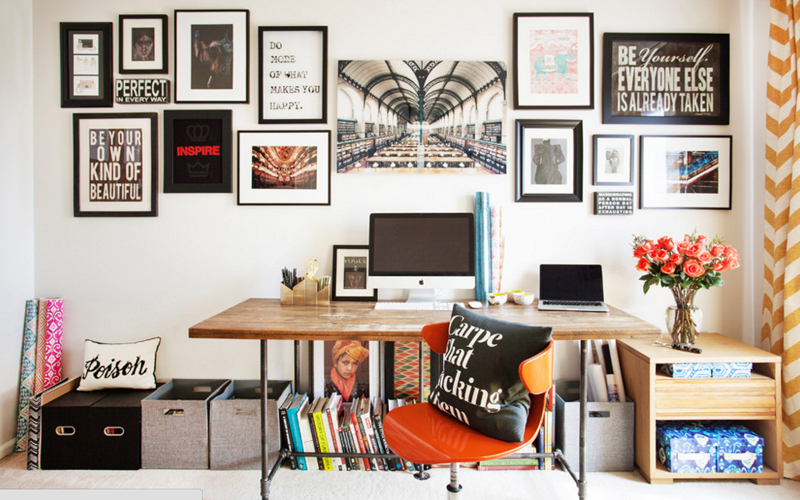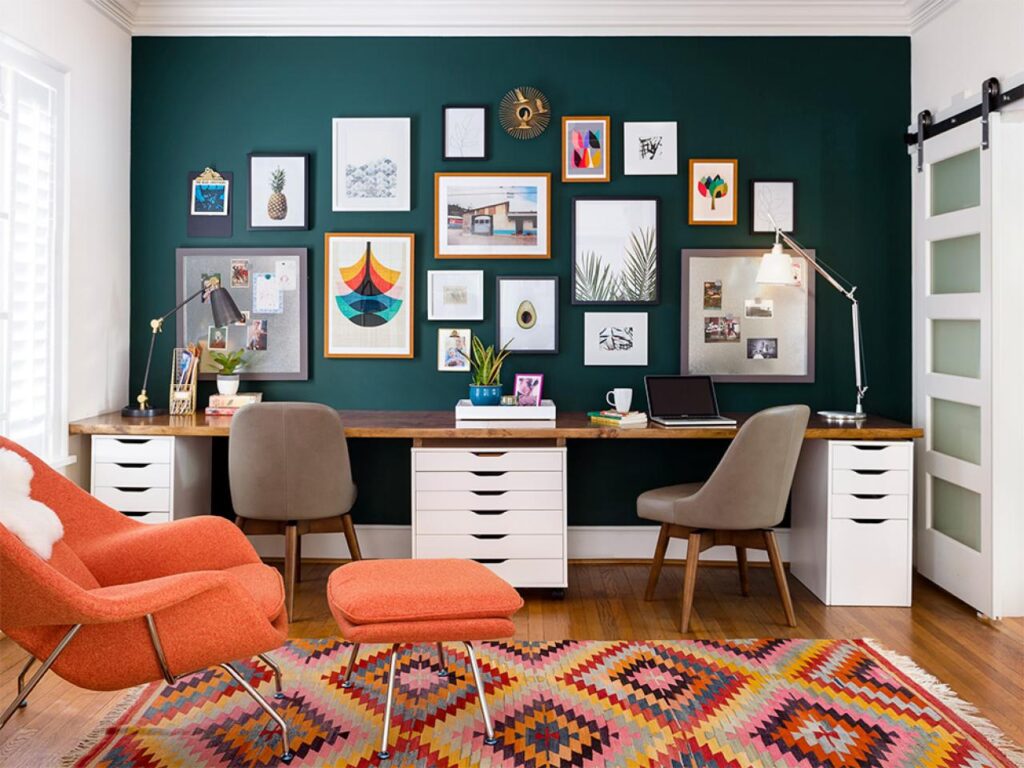In today’s dynamic work environment, the home office has evolved from a mere necessity into a sanctuary of productivity and creativity. Whether you’re working remotely full-time, managing a side hustle, or simply need a designated space for your personal projects, the design of your home office can significantly impact your efficiency, mood, and overall well-being.
This blog post will explore inspiring ideas and practical tips for designing a home office that is both functional and aesthetically pleasing.

Defining Your Needs and Space
Before diving into design elements, it’s essential to assess your specific needs and the space you have available. Consider the following questions:
What is your primary function? Will your home office be used for deep work, virtual meetings, or a combination of tasks?
How much space do you have? Are you working with a small nook or a dedicated room?
What are your storage requirements? Do you need extensive shelving or just a few drawers?
Answering these questions will help you tailor your design to fit your lifestyle and work habits.
Choosing the Right Furniture
Ergonomic Chair: Your chair is perhaps the most crucial piece of furniture in your home office. Opt for an ergonomic design that supports your posture and provides comfort during long hours of work. Look for features like adjustable height, lumbar support, and padded armrests.
Desk Selection: Choose a desk that suits your needs and space constraints. A standing desk can be a great option if you prefer the flexibility to alternate between sitting and standing. Alternatively, a spacious desk with built-in storage can help keep your workspace organized.
Storage Solutions: Depending on your requirements, consider adding bookshelves, filing cabinets, or floating shelves. Modular storage systems are versatile and can be adjusted as your needs change.
Creating a Productive Layout
Ergonomic Arrangement: Position your desk so that you have a clear view of your computer screen and ample lighting. Avoid placing your back to the door, as it can create a feeling of vulnerability.
Zoning Your Space: If space allows, create distinct zones for different activities. For instance, you might have a dedicated area for focused work, a reading nook, and a meeting space. This helps in maintaining a clear boundary between work and relaxation.
Lighting: Proper lighting is essential for reducing eye strain and boosting productivity. Incorporate a mix of natural light and task lighting. Desk lamps with adjustable brightness and color temperature can enhance your workspace.
Incorporating Color Psychology
Colors play a significant role in influencing mood and productivity. Here’s a quick guide to color choices:
Blue: Known for its calming and focusing effects, blue can enhance concentration and promote tranquility.
Green: This color is associated with balance and renewal. It can create a refreshing atmosphere and reduce stress.
Yellow: Yellow can stimulate creativity and energy. It’s an excellent choice for areas where brainstorming and ideation occur.
Gray: Neutral and sophisticated, gray can create a professional and focused environment but might be enhanced with accent colors to avoid a cold feeling.
Experiment with these colors on walls, furniture, and accessories to find a combination that resonates with you.
Adding Personal Touches
Artwork and Decor: Personalize your space with artwork, inspirational quotes, or decorative items that resonate with your style. These touches can make your home office feel more like your own and boost your motivation.
Plants: Incorporating greenery can improve air quality and add a touch of nature to your workspace. Consider low-maintenance plants like succulents, pothos, or snake plants.
Personalized Accessories: Use customized office supplies like a unique mouse pad, personalized stationery, or a custom calendar to add a personal touch to your desk.
Integrating Technology
Cable Management: Tidy up your workspace with cable organizers or under-desk cable management systems. This not only keeps your area clean but also reduces distractions and potential hazards.
Tech Gadgets: Invest in tech gadgets that enhance productivity, such as noise-canceling headphones, a high-quality webcam for video calls, or a multi-functional printer.
Ergonomic Tech: Consider accessories like a keyboard tray, monitor stand, or laptop docking station to improve your ergonomic setup and reduce strain.
Maximizing Small Spaces
For those with limited space, creativity is key. Here are some tips for maximizing a small home office:
Vertical Storage: Use wall-mounted shelves and cabinets to free up floor space. Vertical storage solutions help you keep essential items within reach without overcrowding the room.
Foldable Furniture: Consider foldable desks and chairs that can be tucked away when not in use. These options are perfect for small apartments or multi-purpose rooms.
Multi-Functional Furniture: Look for furniture that serves dual purposes, such as a desk with built-in storage or a daybed that can double as a guest bed.
Creating a Comfortable Atmosphere
Temperature Control: Ensure your home office has adequate ventilation and temperature control. A small fan or space heater can help regulate the temperature and keep you comfortable.
Aromatherapy: Essential oils or scented candles can create a pleasant atmosphere and improve focus. Scents like lavender, peppermint, or eucalyptus can have calming or invigorating effects.
Sound Control: If noise is an issue, consider adding a white noise machine or soundproofing elements to your office. Soft background music can also enhance concentration.
Sustainable Design Choices
Sustainability is becoming increasingly important in home design. Incorporate eco-friendly materials and practices into your home office:
Recycled Materials: Opt for furniture made from recycled or sustainable materials. Many companies now offer eco-friendly office supplies and decor.
Energy-Efficient Lighting: Use LED bulbs and energy-efficient lighting solutions to reduce your energy consumption.
Upcycled Furniture: Consider repurposing or upcycling old furniture to give it a new life while reducing waste.
Inspiring Home Office Examples
Minimalist Elegance: A minimalist home office features a clean, clutter-free design with a neutral color palette, sleek furniture, and ample natural light. This approach emphasizes simplicity and functionality, creating a serene workspace.
Industrial Chic: An industrial-style home office combines exposed brick, metal furniture, and raw materials. This design exudes a modern and edgy vibe, perfect for creative professionals.
Scandinavian Comfort: Scandinavian design focuses on light colors, natural materials, and cozy elements. A Scandinavian home office often includes light wood furniture, soft textiles, and plenty of plants.
Bohemian Vibes: For a more eclectic and relaxed atmosphere, a bohemian-inspired home office includes vibrant colors, patterned textiles, and an array of unique decor items. This style reflects a creative and free-spirited personality.
Conclusion
Designing a home office that is both functional and inspiring requires thoughtful consideration of your needs, preferences, and space constraints. By choosing the right furniture, creating a productive layout, incorporating color psychology, and adding personal touches, you can craft a workspace that enhances your productivity and well-being. Whether you’re working with a small nook or a spacious room, these home office design ideas and tips will help you create a home office that is uniquely yours—a place where work feels less like a chore and more like an enjoyable part of your daily routine.



